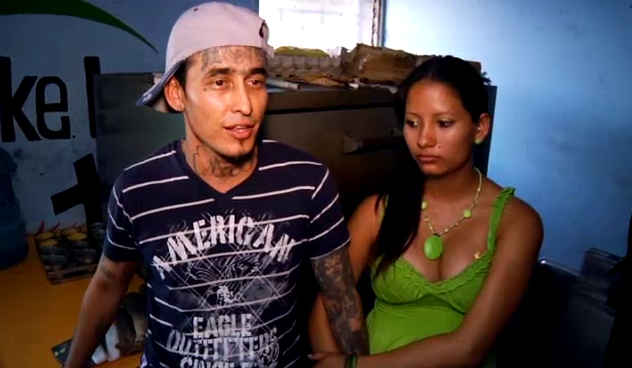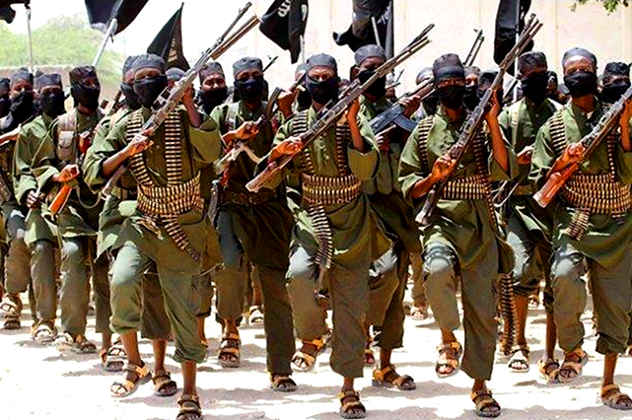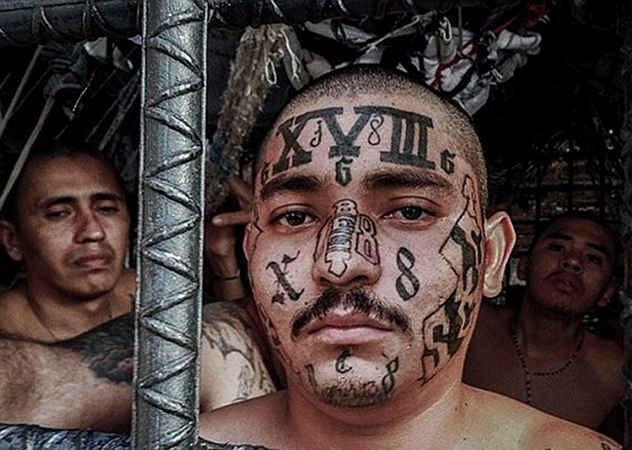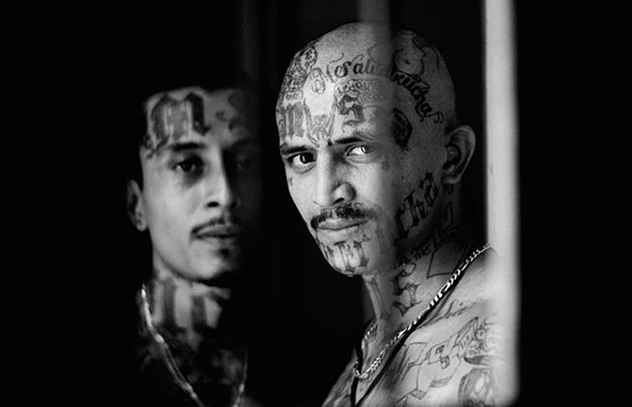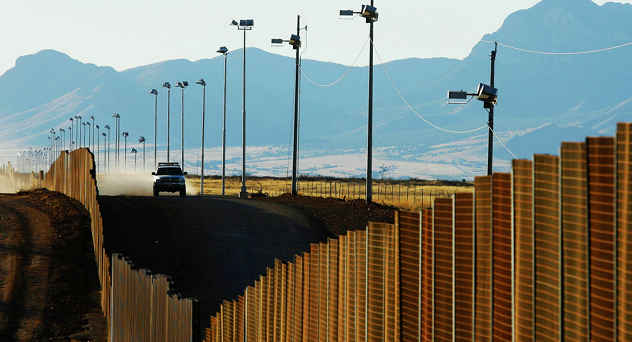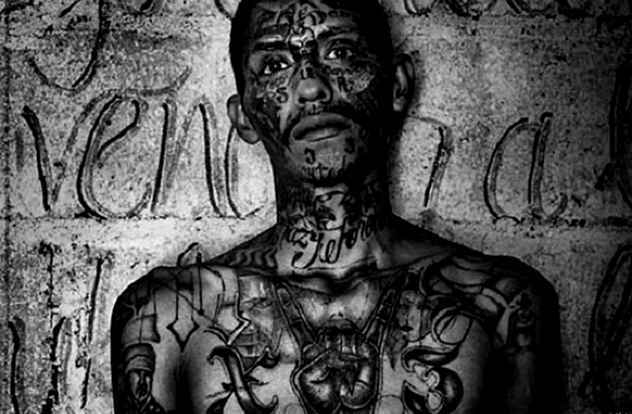“Kill, Rape, Control,” that is the motto of one of the most feared transnational gangs: Mara Salvatrucha (MS-13). Members of this gang are located across 42 states, and numerous countries. Hidden in plain sight, they may not even be hiding at all, as they are known for their brazen actions—they could even be lurking in your hometown. Members first came to the United States between 1980-1990, fleeing their home country of El Salvador during a gruesome civil war. They soon formed MS-13, claimed small towns and cities as their own, and have been wreaking havoc ever since, with no sign of slowing. Gang life is not for the faint of heart; their average life expectancy comes in at around 35 years, due to the extreme unlikelihood of encountering health care and lack of utilization of modern medicine. Most easily identified by their tattoos, Virginia attorney Greg Hunter stated: “There’s a tattoo MS-13 members get—three dots in a triangle—that signify the only three destinations in life for gang members: prison, hospital or the graveyard.”
10Treatment of Women
Just as we have recently seen women being unexplainably attracted to join terrorist groups such as ISIS on their accord; similar instances occur within MS-13 as well. To most of us, it is unfathomable to envision ourselves falling prey to the seduction of a gangster, for some women it’s a reality. The young women who get suckered into this life are those who have no place to go, are naive, and are without family. Maybe it is partly fantasy, derived from what we see depicted in the movies: the bad boy suddenly changed by love and leaves behind his life of crime. This is most certainly not the reality that the women of MS-13 face. Their track record speaks for itself. A well-known story is that of Brenda Paz, MS-13 member turned informant. Her tale began when she was a young girl as she ran away from home to start her endeavors in gang life. Years later she was detained by the police, where she was then convinced to testify and serve as a witness against her fellow gang members. It was only three weeks after she slipped her witness protection that her mutilated body was recovered by fishermen. “The system failed Brenda, and she failed herself. I just hope we now can do better for kids like her because of what we learned from Brenda.” Va. attorney Greg Hunter said.[1] Objects to be used and discarded is an accurate description of this gang’s treatment, or lack thereof, of women. In an interview, an El Salvador native, Rev. Gerardo Mendez recounts that gang members would kill “his woman” for the most minute reasons. He describes it as Neolithic.
9Ties to International Terrorism
It’s like one of those Marvel comics where all the superheroes team up together, but in this case, it’s the villains coming together to wreak havoc on innocent citizens. Back in 2004, it was confirmed that an al-Qaeda lieutenant met with leaders of MS-13.[2] Making nice to the local gangs would prove useful to terrorists. Misery loves company! The gang, unfortunately, had great success with smuggling and avoiding detection by the US Government, and it is assumed this meeting was to share their tips and tricks. Well, and probably broker a deal that incorporated smuggling of some sorts. In their home country El Salvador, MS-13 had already been designated as a terrorist organization. The United States is still toying with the idea of recognizing them as terrorists; they are still reviewing their resume. The new administration has taken a particular interest in MS-13, President Trump has even tweeted about them. On April 8, 2017, Attorney General Jeff Sessions was quoted as saying, “We’re not going to allow them to take over a block, a corner of our communities and terrorize people with this violence.” He spoke about how the Trump Administration will invoke a zero-tolerance policy for gang violence, as well as reforms to the H-1 B visa program. These changes aim to make it more difficult for career criminals, such as MS-13 members, to obtain visas.
8Toxic Rivalry
Barrio 18, formed in Los Angeles as well, has maintained its place as MS-13’s sworn enemy since its conception. They are also sometimes referred to as 18th Street. It is estimated that Barrio 18 has upwards of 35,000 active members. The war between the two gangs has left El Salvador in the crossfire. Even though both gangs have other mutual stomping grounds, El Salvador, being their homeland, has endured the brunt of their unsavory rivalry. The city of San Pedro Sula is known for being one of the world’s most violent cities, due to the presence of both gangs. They maintain a homicide rate of 142 of every 100,000 people. This rivalry has driven many from their homes every year. Brokered by the El Salvador government, a truce was conceived to mend ways between MS-13 and Barrio 18, what a novel idea, so they thought. There was a brief time of peace, but chaos swiftly caught up, leaving the country devastated. When the truce collapsed within one month, 481 people were murdered, approximately 16 people per day.[3] It is thought that the truce collapsed due to the new administration cracking down on gang tolerance. The new president, Sanchez Ceren, came in hot and the country paid the price. This record breaking month helped secure El Salvador as the deadliest country during peacetime.
7El Salvador in Ruins
An outbreak of civil war had lasting impacts on the country of El Salvador and can even be credited with the conception of one of the worst gangs in modern history. When civil war broke out, many fled to the United States, where they formed gangs or joined previously established ones. Not long after these young Salvadoran men became settled into their new lives as gangsters, the game changed. In 1996, Congress passed a law allowing the deportation of any and all immigrants who had received a jail sentence of one year or more. Returning to their home country that was still recovering from civil war, MS-13 began to take over. The lack of infrastructure allowed for the gang to settle right into the driver’s seat. The country’s gangs have almost complete hegemonic control over the vast majority of the country. This poses a significant threat to the severity of the country and makes (legal) economic growth almost impossible. Many citizens find themselves in a tight bind. They either have to pick up and move or pay dues to local gangs to receive protection and security for their families, homes, and businesses.[4] Even though it is well documented that violence was old hat for El Salvador, MS-13 was a new kind of evil.
6Up Close & Personal
Often when we see reports of MS-13 killing, the title reads something along the lines of, “MS-13 Member Accused of Slaying Teens,” not “MS-13 Shooting.” Historically this specific gang has been known for its use of machetes as opposed to guns. Some theorize that this is due to ease of access, but most likely it has something to do with the gang’s roots and the focus of making their crimes more gruesome. This is not to say that they solely use knives in their attacks. No matter which weapon they use, the crimes they commit are equally gruesome and hard to stomach. Some may call them crimes of passion, but the only passion of MS-13 is bloodshed. From baseball bats to knives, this gang rarely partakes in drive-by shootings. Recently within the United States, Long Island residents have experienced an uprise in gang-related homicides. In April 2017, the gang was credited with 11 murders.[5] It is well documented that people are more afraid of a knife attack than being shot. Most of us can relate: the thought of being stabbed sounds horrific, painful, and probably would result in a great deal of suffering. Being shot is seen as being impersonal and a quick death.
5Human Trafficking
Eradicated in the United States over 150 years, slavery is far from being abolished. Modern day human trafficking is not fueled by racism, but by profit. Today we see various forms of human trafficking; exploitation of migrant workers and sexual exploitation of women, children, and at times, men. Robbing its victims of their lives and their rights, human trafficking is a serious offense. With large numbers being trafficked each and every year, it aids in depleting already struggling countries of potential contributing members of society. Prosecutors have historically found human trafficking cases challenging, and at times, nearly impossible to bring to trial. With legal barriers and requirements, unfortunately for the victims, the odds of achieving justice through the court are generally stacked against them. Evidently lacking in moral standards and a sense of value for human life, it is to no surprise that MS-13 is notorious for human trafficking. A lot of times we think about human trafficking as being a problem that solely third world countries encounter. However, this is far from true. Trafficking and prostitution rings are very prevalent in the United States.[6] A source of income for the gang, that is how they view the exploitation, sale, and assault of women and children. Most of the time trafficking comes at little to no cost to the gang, as long as they don’t get caught, this is what makes it an attractive industry to criminals.
4Threat to Border Control
A hot-button issue in the United States: Border Control. To build the wall or not. The stigma is that gangsters are uneducated, making them remedial. MS-13 makes it clear that you do not have to have an MBA to be a successful criminal. With much of their business coming from smuggling people, weapons, and substances across the US-Mexican Border, the gang has a lot at stake. This means that they will not let Border Patrol come between them and their paycheck (not an actual paycheck, I’d imagine they get paid in cash—presumably unmarked bills). According to recent statistics, 92 percent of MS-13 gang members arrested are in the United States illegally,[7] meaning they are well-versed in the art of “hopping the fence,” getting caught once on the other side, not so much apparently. The largest border apprehension to date occurred in February 2005. An MS-13 member had escaped from a Honduran prison and was transporting narcotics across the border when he was stopped by a trooper. The gang member was accompanied by other MS-13 crminals; they opened fire on the Department of Public Safety trooper. Twenty-eight people were killed during this deadly exchange of gunfire.
3Tough to Tackle
How does one go about stopping a transnational gang that is so deeply embedded in certain societies that without them would cease to exist? World leaders and law enforcement struggle with this question. Gangs such as MS-13 are parasites that render entire countries, cities, and communities lifeless. “They are getting more disciplined and more organized. And they’re getting smarter,” said Susan Ritter, chairwoman of the criminal justice department at the University of Texas at Brownsville. What about the police? Police enforcement is a good start. However, it is not a cure-all. A community center head out of Buffalo was quoted saying, “when they shut down a drug house, it just moves down the street.” Ironically, police crackdowns bring people together. When the men in blue start poking around, gang members band together, forming closer connections and stronger ties to the community. The Department of Justice’s “Weed and Seed”[8] tactic offers promise. It includes weeding out the top tier gang members and seeding the neighborhood with economic means and resources to prevent further gang activities. It is quite a novel idea if you consider that the “top tier” gang members got to where they are by climbing the ranks while remaining elusive and undetected. What is scarier than a ruthless gang? A transnational gang. El Salvador, Mexico, United States, Honduras, Guatemala, and even parts of Canada are all countries in which MS-13 has staked its claim. They are expanding and show no signs of halting their spread anytime soon. Some reports even state that members of MS-13 have set up camp in Australia. As they strengthen their hold on territories they already control, it becomes more difficult to remove them.
2Recruiting in a City Near You!
It’s bad enough that these gangs exist throughout the world in the first place, but preying on young boys and girls makes MS-13 even sicker. The tactic is to find youths who are coming from Central America to the US. This way they have nowhere else to go and limited resources to aid them in avoiding the gang life. If there is nobody to know that the children are missing in the first place, even better. Their initiation process is brutal, and everything you would imagine of a gang. Committing murder, getting beaten, and branded with tattoos are only some of the known aspects of their process.[9] Not joining can be even more dangerous in most cases.
1A Market of Their Own
Criminals don’t pay taxes on their smuggled weapons or kidnapped teens. Ruling the streets comes with perks, well not perks that would entice most. They make the rules, and they make money. Simple. Extortion, murder for hire, trafficking, smuggling, the list goes on—all business opportunities that MS-13 utilizes to the fullest extent. They are no drug lords in comparison to the Mexican cartels, but they make money none the less. With such a strong following it is easy for the gang to make their rules and charge what they like for their services. Drugs seem to be the common linkage between most gangs. Whether they are transporting, selling, or consuming, they are involved in one way or another. We are not talking about marijuana. Gangs tend to gravitate towards substances such as crack cocaine and PCP. There have been reports made that MS-13 has maintained steady relationships with Mexican drug cartels, and at times aided them in smuggling operations. Extortion fees are just another, equally as immoral, form of income MS-13 collects. With their large numbers and violent reputations, they are able to scare locals into paying them off with ease. Often they will make shop owners or families pay to ensure their safety, if they do not, they could fall prey to the gang’s rage.[10]
